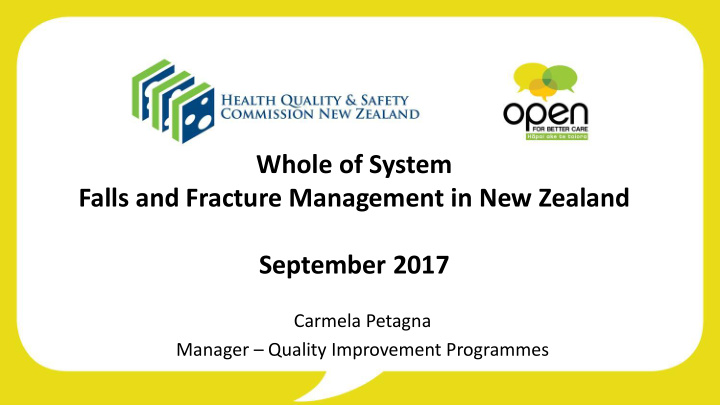



Whole of System Falls and Fracture Management in New Zealand September 2017 Carmela Petagna Manager – Quality Improvement Programmes
Today ….. • Cross agency collaboration – central agencies / sector partnerships • Unifying brand and population health approach • Best Practice and Outcome Framework
The journey
Who are we ? • Accountability / Mandate - leads New Zealand’s health and disability system, and has overall responsibility for the management and development of that system. • Insurer – a no fault insurer cover for those injured in an accident. This includes children, beneficiaries and students. It doesn’t matter if they’re working, unemployed or retired. • Influence / Collaborator - Independent crown entity - partners across the health and disability sector to improve the safety and quality of services to improve experience and outcomes for all New Zealanders.
Cross-agency collaboration ACC is committed to: HQSC’s ongoing focus: • Leadership and guidance, including creating alliances across key annual April Falls ‘campaign’ and stakeholders to support a population establishing regional clinical leadership level approach network (lead, engage and sustain the gains) making a contribution as a partner in the health system • Continue to be the ‘go - to’ for evidence - based resources, such as the 10 Topics building on the previous work by the (maintain the evidence base) Health Quality & Safety Commission • and DHBs which focused Ongoing measurement for predominantly on in-hospital falls improvement – i.e. QSMs and outcome framework (with ACC) aligning reporting with the Ministry (measure and monitor) requirements
Alliances at all levels of the system
A unifying brand that engages target audiences and has sector cut-through
Working together- more in common than not… • Value of older people in our society • Fall & fracture is an injury & more…. • Sustainable approach to funding Health & Insurer – ACC collaborating with partners • Evidence @ population level Common goal to keep Muriel independent & well @ home 8
Falls and fracture outcomes for New Zealand’s older people - a whole of system approach
Whole of System Approach Central Agency and DHB - contribution to support delivery . A national outcomes and best practice framework guides the design of local services, setting of delivery expectations and monitoring of results. The benefits for the health system will be less than predicted claims costs , fewer admissions to hospital and aged residential care , and reduced hospital length of stay . For an older person the benefit will be improved quality of life and independence .
What are the key components of the falls and fracture system? Wellness - Community Strength & Balance , Safer Homes, consumer information, support older people to stay well and independent in their own homes. Fracture Liaison Services (FLS) - coordinator-based, secondary fracture prevention services implemented by health care systems that identify those with or at risk of fragility fractures In-home and Community Strength and Balance programmes – supporting the needs of older people with both individual and group-based Early supported discharge - service delivery models that enable flexibility in the place of rehabilitation for older people Integration effort – enables the ability to build partnerships, pathways and an outcomes framework to support the falls & fracture system for New Zealand
Fracture Liaison Service • Older people who have sustained a fragility fracture in the past are much more likely to have another fracture – potentially hip. • The Fracture Liaison Service identifies those with or at risk of fragility fractures and: – prescribes/recommends bisphosphonates – refers to an evidenced based strength and balance programme.
Community Group Strength and Balance • There is evidence that community- based, multi-functional exercise programmes, targeted at improving strength and balance in older people can reduce the risk of falling by 29% . • A population based approach is needed if a significant reduction in falls across the older population can be achieved. • In practice, this means that many thousands of people across NZ at risk of falling, should participate in effective, evidence-based community group strength and balance classes.
In-Home Strength and Balance • There is strong evidence that in-home strength and balance and strength programmes such as the OEP can reduce the rate of falls by 32%. • Most appropriate for those who have poor strength & balance and are too frail for or have no access to community group-based falls prevention exercise programmes. • This programme is not suitable for people in rest home or hospital care. • ACC has partnered with DHBs to support the expansion of in-home strength and balance programmes in their regions. • A Technical Advisory Group (TAG) was set up by ACC, to provide criteria based on evidenced best practice for an in home strength and balance programme.
Early supported discharge • Evidence shows that hospital is not the best place to rehab older people • ACC is working with Auckland, Waikato and Canterbury DHBs to pilot a new funding model for the Non Acute Rehabilitation (NAR) event that enables flexibility in the place of rehabilitation for older people.
Fewer fall injuries
Fewer fall injuries
Fewer serious harm fall injuries
Improved recovery in hospital
New resources (these plus more)
Shared resources
National Service Coverage August 2017 FLS & In home Strength & Balance 80% of local health systems 86% of population Group Strength and Balance 95% of local health systems 96% of population
Making it easy for older people & their families - www.livestronger.org.nz 28
In summary • Establish common goals based on all perspectives • Align activities and effort nationally & locally • Measure outcomes together • Work together at multiple levels
Thank you carmela.petagna@hqsc.govt.nz
Recommend
More recommend